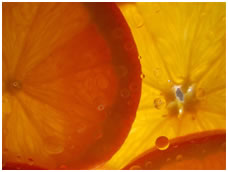Measuring Acidity: the pH scale
 Any time that a measurement can vary over many orders of magnitude, that's a candidate
for using a log scale.
Any time that a measurement can vary over many orders of magnitude, that's a candidate
for using a log scale.
For example, the proper function of biological systems depends on the correct concentration of hydrogen ions (H+, or more correctly, H3O+) in an aqueous solution. This concentration can be as high as 1 M (extremely acidic), or as low as 10-14 M (extremely basic). Instead of counting out the zeros every time, we use a log scale, invented by Soren Sorenson:
extremely acidic : 1M = 100 M, so.... pH = 0
extremely basic : 10-14 M, so.... pH = 14
Notice that Sorenson chose to drop the minus sign, so our extreme base has a pH of 14, not -14. This is nice because we avoid negative numbers, but a bit tricky, since it means that the BIGGER the pH, the LOWER the concentration of H+.
The end result of all of this is that neutral solutions have a pH of 7, while a pH below 7 is an acidic solution and a pH above 7 is a basic solution.*
*Fine Print: Although pH technically measures just H+, what's really going on is an equilibrium between H2O, H+ and OH-. This is because water is a weak acid that dissociates into H+ and OH-. The equilibrium constant (K) for this dissociation is:
K = [H+] [OH-] / [H2O] = 1.8 × 10-16 M at 25°C
We can simplify this by noting that there is a large excess concentration of water with a constant molarity of 55.56, so
K [H2O] = [H+] [OH-] = 1.8 × 10-16 × 55.56 = 1 × 10-14 M2,
or simply
K= [H+] [OH-] = 10-14 M2.
When a solution is neutral, [H+] = [OH-], and therefore both [H+] and [OH-] must be 10-7 M, and pH must be 7.
How does the concentration of H+ change as the pH changes? Let's think of pH as a series of steps:
if pH = 7, then [H+] = 10-7M = 0.0000001 M
if pH = 6, then [H+] = 10-6M = 0.000001 M
if pH = 5, then [H+] = 10-5M = 0.00001 M
if pH = 4, then [H+] = 10-4M = 0.0001 M
if pH = 3, then [H+] = 10-3M = 0.001 M
if pH = 2, then [H+] = 10-2M = 0.01 M
if pH = 1, then [H+] = 10-1M = 0.1 M
if pH = 0, then [H+] = 100M = 1 M
Every time we go one "step" on the pH scale, we increase (or decrease) the concentration of hydrogen ions by a factor of 10. This is an important characteristic of using logs:
adding 1 to the log, or subtracting 1 from the log, changes the original unlogged number by a factor of 10 (multiplies or divides by 10).
If you increased the pH of a solution from 4.5 to 5.5, what would happen to the concentration of H+?
(To make this problem interactive, turn on javascript!)
- I need a hint ... : What is the change on the pH scale?
- ...another hint ... : Adding 1 to the pH scale does what to the original number?
- ...another hint ... : Remember that as pH goes up, [H+] goes down
I think I have the answer: 10 times LESS
If you decreased the pH of a solution from 4.5 to 2.3, what would happen to the concentration of H+?
(To make this problem interactive, turn on javascript!)
- I need a hint ... : The change on the pH scale is 2.1
- ...another hint ... : 10^2 = 100 ... so this is APPROXIMATELY the factor that [H+] will change by.
- ...another hint ... : How can you modify 10^2 to get the exact answer?
I think I have the answer: 10^2.1 = 125.9 times MORE
Copyright University of Maryland, 2007
You may link to this site for educational purposes.
Please do not copy without permission
requests/questions/feedback email: mathbench@umd.edu